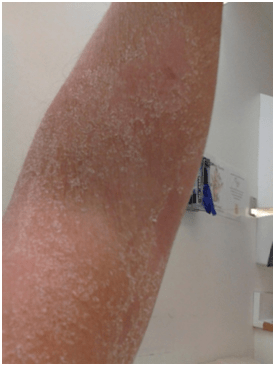CASE REPORT
A 48-year-old male called the poison control center noting his “skin is starting to peel off”. He stated ten days prior, a container fell from a shelf and spilled approximately 100 milliliters of elemental mercury used for gold extraction. Because it was felt there was a still valuable amount of gold in the mercury, he explored the silvery material for any recoverable specs of gold. Once complete, he used a vacuum to remove the mercury, and swept the remainder under a rug. He noted it was a cold January day, and turned the heat on, also noting there was no exhaust ventilation in this room. He felt he might be coming down with influenza-like-illness (ILI), and spent the next week in bed (in this same room).
The patient was referred to the local emergency department (ED), and instructed to notify the county hazardous materials agency of the spill. In the ED, his vital signs were within normal limits. He was noted to have a desquamating rash of his upper and lower extremities, with mild erythema (Figures 1 and 2). He complained of numbness of his fingers and lower extremities. Laboratory tests including a complete metabolic panel and complete blood count were within normal limits. An electrocardiogram and chest x-ray was normal. A whole blood mercury test and spot urine mercury test were obtained and returned (one week later) with values of 262 mcg/L (reference range; <10 mcg/L) and 144 mcg/g creatinine (reference range; non-exposed adult <4 mcg/g creatinine) respectively. The patient was referred to the Occupational and Environmental Clinic, where he was seen four weeks after the initial event. His county public health agency was notified of the event. He denied any tremor, but noted recent personality changes including depression and decreased interest in social interaction. He noted his rash had resolved, but he continued to have a sensory neuropathy, complaining of worsening balance, dizziness, cold sensitivity and numbness of his arms and legs. These neurologic symptoms limited his occupational and recreational activities, including woodworking, playing a musical instrument and dancing. He noted he had relocated from the location of the mercury spill. A repeat whole blood mercury level returned at 13 mcg/L and a twenty-four hour urine collection returned at 44 mcg/L (reference range; <20 mcg/L). Formal neurologic testing was offered, but due to the patient’s lack of health insurance, he was unable to complete this testing. He was lost to follow-up following his clinic visit. The county department of public health was informed about a potential mercury spill at the residence but they were unable to make contact with the patient and the residence was not evaluated.
Figure 1: Left arm.

Figure 2: Left arm, closeup.

DISCUSSION
Small-scale mining of gold using amalgamation continues to occur because it efficiently captures gold and doesn’t require more costly equipment or processes. Once the gold amalgam is collected, it can be heated to distill off the mercury. Often the mercury fumes are not processed appropriately and are discharged into the environment where they can be inhaled by individuals and cause toxicity.1 Our patient did not process the mercury with heat. He had a large spill that was improperly cleaned up. Mercury will volatilize into the air at room temperature and vacuuming will facilitate dispersion. He was further exposed to the mercury vapors because he swept the remaining mercury under a rug, did not have ventilation to the outside and spent a prolonged period in that environment.
Elemental mercury exposure via inhalation has reported neurotoxic effects. Mercury’s purported mechanism of toxicity includes reaction with sulfhydryl groups on proteins of cellular membranes resulting in inhibition of cellular enzymes.2 Because sulfhydryl groups are ubiquitous, mercury can have effects on every organ system. Neurotoxicity due to inhalation of elemental mercury has been described as affecting the central nervous system (CNS) resulting in neuropsychiatric disturbances and movement disorders. Because the nervous system lacks significant detoxification mechanisms (such as glutathione stores or reduction-oxidation activity), it has been theorized that it is particularly sensitive to mercury. Following acute central nervous system manifestations, rarely peripheral nervous effects have been reported. These reports include both motor and sensory neuropathy.
Dermal effects are also described, including a mercury exanthem with diffuse and symmetric erythematous maculopapular eruptions beginning in the flexural areas and proximal extremities within a few days of exposure.3 Fever, malaise, and thirst can accompany this, mimicking an infectious illness. The condition clears with extensive desquamation, particularly on the hands and feet, at around 14 days. Diagnosis depends on integrating characteristic findings with a history of known or potential exposure, along with elevated mercury blood or urinary excretion levels. Our patient was clearly exposed to mercury fumes. Unfortunately, the county department of public health was unable to make contact to evaluate the residence and document air levels. He presented with a desquamating rash and numbness of his fingers and lower extremities. The rash had resolved on follow-up four weeks later. He experienced depression, anhedonia, diminished balance, dizziness, sensory neuropathy with cold sensitivity with numbness of his arms and legs. Whole blood mercury and urinary excretion levels were elevated 10 days after the initial mercury spill and remained elevated four weeks later. All symptoms consistent with a diagnosis of mercury toxicity.
With the increases in the price of gold, artisanal gold mining has experienced resurgence, both in the United States and Internationally. The risk for mercury exposure is significant.4 Elemental mercury exposure can be toxic to multiple organ systems, including the nervous and dermatologic systems. Clinical manifestations can vary. The index of suspicion must be raised in people working with jewelry or gold recovery. The risk is increased when patients are handling seemingly innocuous materials. Public health authorities should be notified when suspicious cases arise, as they may result in multiple exposures.
CONFLICTS OF INTEREST
The authors declare that they have no conflicts of interest.







